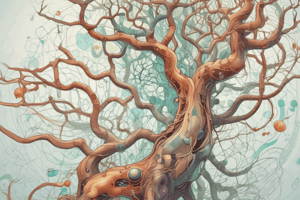Podcast
Questions and Answers
What is the primary function of the mitochondria?
What is the primary function of the mitochondria?
- Generating energy (ATP) (correct)
- Breaking down cellular waste
- Protein synthesis
- Storing DNA
Which organelle is responsible for breaking down and recycling cellular waste?
Which organelle is responsible for breaking down and recycling cellular waste?
- Lysosomes (correct)
- Endoplasmic Reticulum
- Golgi Apparatus
- Ribosomes
What is the process by which a cell divides into two daughter cells?
What is the process by which a cell divides into two daughter cells?
- Cell Division (correct)
- Protein Synthesis
- Cell Signaling
- Metabolism
What is the jelly-like substance inside the cell where metabolic processes take place?
What is the jelly-like substance inside the cell where metabolic processes take place?
What is the control center of the cell where DNA is stored?
What is the control center of the cell where DNA is stored?
What type of cells lack a true nucleus?
What type of cells lack a true nucleus?
Flashcards are hidden until you start studying
Study Notes
Cell Structure
- Plasma Membrane: Semi-permeable membrane that surrounds the cell, regulating what enters and leaves.
- Cytoplasm: Jelly-like substance inside the cell where metabolic processes take place.
- Nucleus: Control center of the cell where DNA is stored.
- Mitochondria: Powerhouses of the cell, responsible for generating energy (ATP).
- Endoplasmic Reticulum (ER): Network of membranous tubules and cisternae involved in protein synthesis and transport.
- Ribosomes: Small organelles found throughout the cytoplasm, responsible for protein synthesis.
- Lysosomes: Membrane-bound sacs containing digestive enzymes, responsible for breaking down and recycling cellular waste.
- Golgi Apparatus: Complex of flattened sacs and tubules involved in protein modification and packaging.
Cell Functions
- Metabolism: Conversion of energy and nutrients into ATP.
- Protein Synthesis: Creation of proteins from amino acids.
- Cell Division: Process by which a cell divides into two daughter cells.
- Cell Signaling: Communication between cells through signaling pathways.
- Cell Adhesion: Interaction between cells and their environment.
Cell Types
- Prokaryotic Cells: Simple cells lacking a true nucleus, found in bacteria.
- Eukaryotic Cells: Complex cells with a true nucleus, found in plants, animals, fungi, and protists.
Cell Cycle
- Interphase: Cell growth and preparation for cell division.
- Mitosis: Nuclear division resulting in two daughter cells with identical DNA.
- Cytokinesis: Division of the cytoplasm and cell separation.
Cellular Transport
- Passive Transport: Movement of molecules from high to low concentration without energy input (diffusion, osmosis).
- Active Transport: Movement of molecules from low to high concentration using energy input (carrier proteins).
Cell Structure
- Plasma membrane is semi-permeable, regulating what enters and leaves the cell.
- Cytoplasm is a jelly-like substance where metabolic processes take place.
- Nucleus is the control center of the cell, storing DNA.
- Mitochondria are the powerhouses of the cell, generating energy (ATP).
- Endoplasmic Reticulum (ER) is a network of membranous tubules and cisternae involved in protein synthesis and transport.
- Ribosomes are small organelles found throughout the cytoplasm, responsible for protein synthesis.
- Lysosomes are membrane-bound sacs containing digestive enzymes, breaking down and recycling cellular waste.
- Golgi Apparatus is a complex of flattened sacs and tubules involved in protein modification and packaging.
Cell Functions
- Metabolism involves the conversion of energy and nutrients into ATP.
- Protein synthesis is the creation of proteins from amino acids.
- Cell division is the process by which a cell divides into two daughter cells.
- Cell signaling involves communication between cells through signaling pathways.
- Cell adhesion involves the interaction between cells and their environment.
Cell Types
- Prokaryotic cells are simple cells lacking a true nucleus, found in bacteria.
- Eukaryotic cells are complex cells with a true nucleus, found in plants, animals, fungi, and protists.
Cell Cycle
- Interphase involves cell growth and preparation for cell division.
- Mitosis involves nuclear division, resulting in two daughter cells with identical DNA.
- Cytokinesis involves the division of the cytoplasm and cell separation.
Cellular Transport
- Passive transport involves the movement of molecules from high to low concentration without energy input (diffusion, osmosis).
- Active transport involves the movement of molecules from low to high concentration using energy input (carrier proteins).
Studying That Suits You
Use AI to generate personalized quizzes and flashcards to suit your learning preferences.




